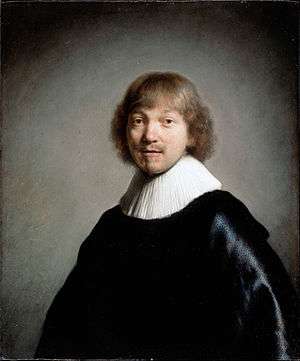Portrait of Jacob de Gheyn III
Portrait of Jacob de Gheyn III is a 1632 oil on canvas portrait by Rembrandt of the engraver Jacob de Gheyn III, now in Dulwich Picture Gallery. It is smaller than most of Rembrandt's works, measuring only 29.9 by 24.9 centimetres (11.8 by 9.8 inches). It has been stolen numerous times and its size is one factor that has contributed to its numerous thefts.[1]

The commission
Huygens and de Gheyn had commissioned Rembrandt to paint them in identical formats and he did so upon the same oak panel.[2] The friends had agreed that the first of them to die would receive the painting owned by the other, as evidenced by inscriptions on their reverse.[3] They were reunited when de Gheyn died. Maurits Huygens survived De Gheyn by less than a year however, and his brother Constantijn Huygens was so heartbroken that he stopped writing for a long period. Dendrochronological research has revealed that Rembrandt also made a self-portrait in the same year with a panel from the same wood:
 Self-portrait
Self-portrait Pendent of Maurits Huygens
Pendent of Maurits Huygens
Thefts
The painting has been given the moniker "takeaway Rembrandt" as it has been stolen four times since 1966 – the most recorded of any painting.[4][5]
Between 14 August 1981 and 3 September 1981 the painting was taken from Dulwich Picture Gallery and retrieved when police arrested four men in a taxi who had the painting with them.[1][6] A little under two years later a burglar smashed a skylight and descended through it into the art gallery, using a crowbar to remove the painting from the wall. The police arrived within three minutes but were too late to apprehend the thief.[7] The painting was missing for three years, eventually being found on 8 October 1986 in a luggage rack at the train station of a British army garrison in Münster, Germany.
The other two times, the painting was found once underneath a bench in a graveyard in Streatham, and once on the back of a bicycle.[8] Each time the painting has been returned anonymously with more than one person being charged for its disappearance.[5]
References
- "Rembrandt painting stolen for fourth time". UPI. 28 May 1983. Archived from the original on 3 July 2019. Retrieved 3 July 2019.
- Dulwich Picture Gallery. 2006. "Jacob de Gheyn III" Accessed 4-jun-2010.
- Graham-Nixon, Andrew. The Daily Telegraph. 11 June 2006. " Archived 2006-06-15 at the Wayback Machine". Accessed 6 September 2006.
- Alberge, Dalya. The Times. 23 August 2004. "Mystery, intrigue and stolen paintings". Accessed 3 September 2006.
- Guinness World Records. "Most Stolen Painting Archived 2018-08-05 at the Wayback Machine". Accessed 4 September 2006.
- New York Times Archives. 3 September 1981. "Around The World; Painting by Rembrandt Is Recovered in London Archived 2007-03-19 at the Wayback Machine". Accessed 3 September 2006.
- Time. 4 July 1983. "Stop and Think: Supercrooks do brisk business Archived 2013-08-28 at the Wayback Machine". Accessed 6 September 2006.
- Kennedy, Maev. The Guardian. 18 May 2001. "Artful conman preys on wealthy". Accessed 3 September 2006.